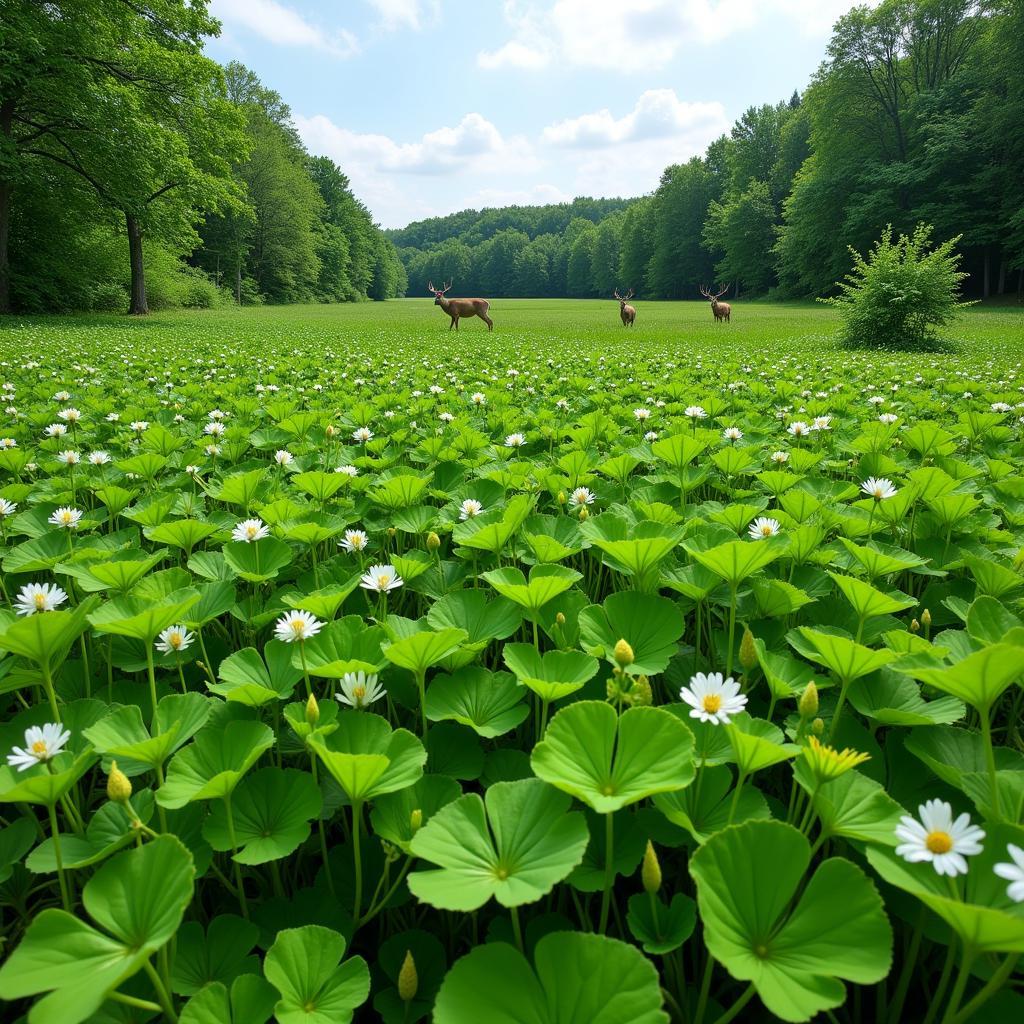Michigan’s diverse landscape and healthy deer population make it a haven for hunting enthusiasts. A key factor in successful deer hunting lies in understanding the best food plots to attract and grow a thriving deer herd. Whether you’re a seasoned hunter or just starting, selecting the right food plots can make all the difference.
 Best Food Plots for Michigan Deer: A Lush Clover Plot
Best Food Plots for Michigan Deer: A Lush Clover Plot
Why Food Plots Matter for Michigan Deer
Food plots provide supplemental nutrition, especially during crucial periods like the rut and winter. They can help improve the overall health and antler growth of the deer population in your hunting area.
Top Food Plot Choices for Michigan’s Climate and Soil
Michigan’s climate and soil conditions favor specific types of food plots. Here are some top performers:
1. Clover: A Nutritional Powerhouse
spring deer food plots are a popular choice for many hunters, and clover is no exception. Clover is a highly attractive and nutritious option that thrives in Michigan. It’s packed with protein and offers excellent palatability, making it a favorite among deer.
- Types: Red clover and white clover are popular choices for Michigan.
- Planting Time: Early spring or late summer for optimal growth.
- Benefits: High in protein, attracts other wildlife, provides year-round forage.
2. Brassicas: Cold-Tolerant Forage
Brassicas, like turnips and radishes, are excellent for late-season food plots in Michigan. They offer cold tolerance and provide essential nutrients when other food sources become scarce.
- Types: Purple top turnips, forage radishes, and kale.
- Planting Time: Late summer to early fall.
- Benefits: Cold-hardy, high in carbohydrates and energy, attractive during the late season.
3. Soybeans: A Summer Staple
Soybeans are a warm-season annual that provides excellent forage and cover for deer during the summer months. They are high in protein and energy, supporting antler growth and overall health.
- Planting Time: Late spring to early summer.
- Benefits: High protein content, attractive during summer, provides cover for fawning.
4. Alfalfa: A Long-Term Investment
While it requires specific soil conditions, alfalfa can be a highly productive food plot option in Michigan. It’s a perennial legume known for its longevity and high nutritional value.
- Planting Time: Spring or late summer.
- Benefits: Long-lived perennial, high in protein and calcium, can provide several years of forage.
Planning and Maintaining Your Michigan Food Plot
1. Soil Testing: The Foundation of Success
Before planting, conduct a soil test to determine its pH and nutrient levels. This will help you choose the right food plot species and ensure optimal growth.
2. Location is Key: Consider Sunlight and Accessibility
Select a location that receives ample sunlight (at least 6 hours) and is easily accessible for planting and hunting.
3. Weed Control: A Must for Success
Implement effective weed control strategies before and after planting to prevent competition with your chosen food plot species.
4. Best Late Season Deer Food Plot: Timing is Everything
Consider planting a mix of species that mature at different times to provide year-round forage. For example, combine clover, which thrives throughout the year, with brassicas for a reliable late-season food source.
 Michigan Deer Food Plot: A Mix of Clover and Brassicas
Michigan Deer Food Plot: A Mix of Clover and Brassicas
Expert Insights
“In my years of experience managing deer habitat in Michigan, I’ve found that a well-planned food plot strategy can significantly enhance deer health and antler development,” says Mark Johnson, a certified wildlife biologist based in Michigan. “Don’t underestimate the impact of soil testing and choosing species adapted to your region.”
Conclusion
Creating the Best Food Plots For Michigan Deer involves understanding your local environment, soil conditions, and deer preferences. By selecting the right species and implementing proper management practices, you can create attractive and nutritious food sources that benefit the deer herd and enhance your hunting experience. Remember, a thriving deer population starts with providing them with the resources they need to thrive.
FAQs about Food Plots in Michigan
1. What is the best time to plant a food plot in Michigan?
The optimal planting time varies depending on the specific species. However, spring and late summer are generally favorable for most food plot options in Michigan.
2. How big should my food plot be?
The ideal size depends on your property size and deer density. As a general rule, aim for a food plot that’s at least half an acre to provide sufficient forage.
3. Can I plant a food plot on public land in Michigan?
Planting food plots on public land is typically prohibited. Consult the Michigan Department of Natural Resources (DNR) for specific regulations in your hunting area.
4. Clover Seed for Food Plots: How do I choose the right type?
Red clover is a great option for spring planting, while white clover thrives in late summer. Consider a mix for diverse forage.
5. Best Deer Food Plot for Michigan: What is the absolute best option?
The best option varies depending on your specific location, soil, and goals. However, clover and brassicas are consistently top performers in Michigan.
For further assistance or personalized advice on establishing food plots, please contact our team at 02437655121, email us at minacones@gmail.com, or visit us at 3PGH+8R9, ĐT70A, thôn Trung, Bắc Từ Liêm, Hà Nội, Việt Nam. Our dedicated customer service team is available 24/7 to answer your questions and guide you towards a successful hunting season.